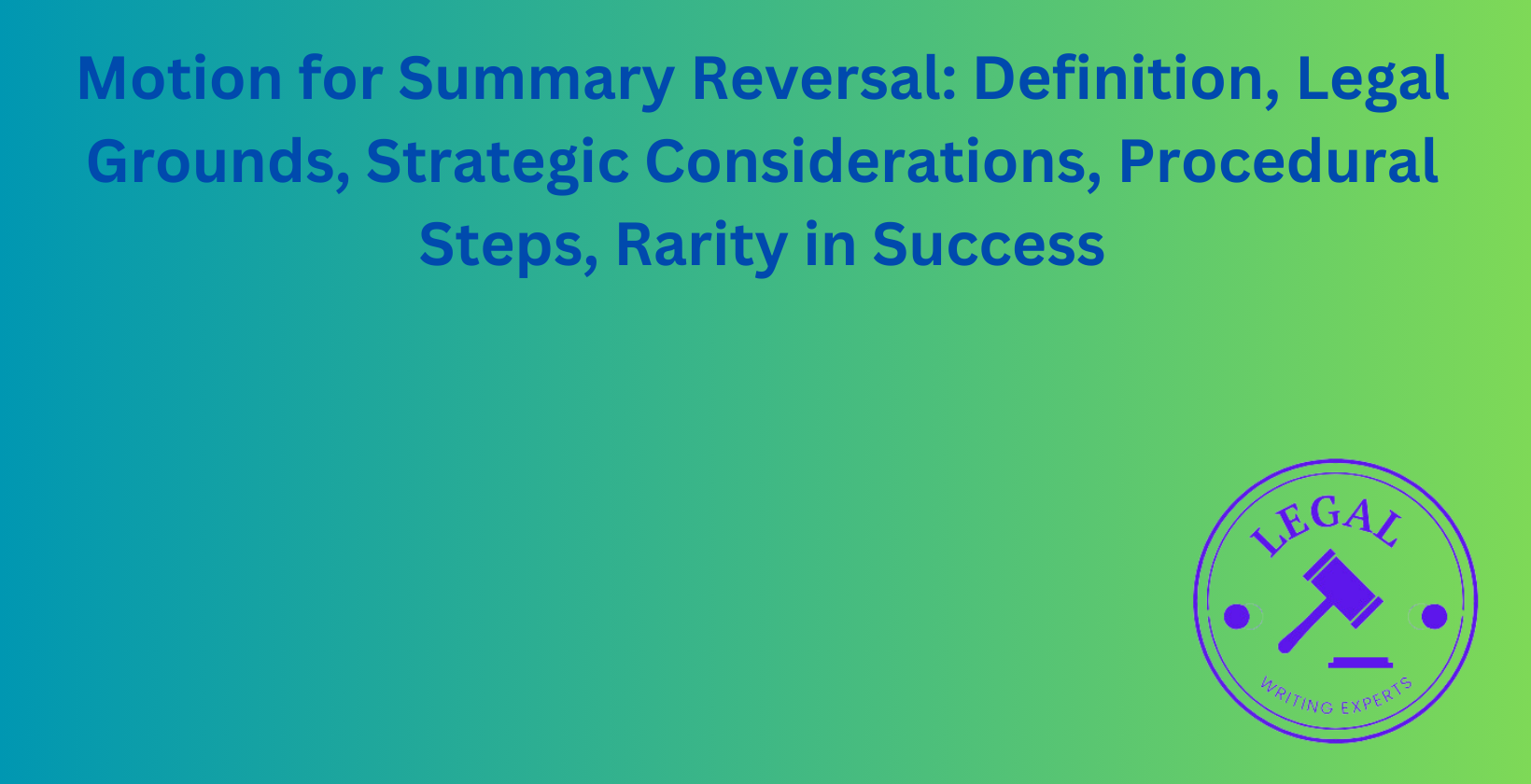Motion for Summary Reversal
Written by
Jessica E
October 1, 2024 · 8 min read

A motion for summary reversal is a legal procedure used in appellate courts to request the reversal of a lower court’s decision without full briefing or oral arguments. This article explores the definition, legal grounds, strategic considerations, procedural steps, and rarity of success for motions for summary reversal. We’ll examine how to write and file such motions, the legal grounds supporting them, timing considerations, court discretion, common case examples, and key differences from summary judgment. Understanding these aspects is crucial for attorneys and litigants considering this expedited appellate option.
What Is a Motion for Summary Reversal?
A motion for summary reversal is a request made to an appellate court to overturn a lower court’s decision without going through the full appeal process. This expedited procedure allows the appellate court to reverse a ruling quickly when the error in the lower court’s decision is clear and indisputable. Summary reversals are typically reserved for cases where the lower court’s error is obvious and correction is necessary to prevent a miscarriage of justice.
How to Write a Motion for Summary Reversal?
Writing a motion for summary reversal requires a clear and concise presentation of the legal error committed by the lower court. The motion should begin with a brief statement of the case and procedural history. Next, outline the specific legal grounds for reversal, citing relevant case law and statutes. Provide a detailed analysis of why the lower court’s decision was erroneous and explain how it conflicts with established legal principles. Conclude with a strong argument for why summary reversal is appropriate in this case, emphasizing the clarity of the error and the need for swift correction.
Where Can I Hire a Legal Writer to Draft a Motion for Summary Reversal?
Legal writers experienced in drafting motions for summary reversal can be hired through Legal Writing Experts channel. Legal Writing Experts often have in-house legal writers or contract with freelance legal writers for such specialized tasks. Legal Writing Experts is an online platform with legal writing professionals who specialize in appellate motions and briefs. We provide our clients with qualified legal writers with expertise in appellate practice.
How to File a Motion for Summary Reversal?
Filing a motion for summary reversal involves several steps. First, review the appellate court’s rules regarding motion practice and any specific requirements for summary reversal motions. Prepare the motion document according to these rules, including proper formatting and citation style. File the motion with the clerk of the appellate court, paying any required filing fees. Serve copies of the motion on all parties involved in the case, following the court’s service requirements. File a proof of service with the court to confirm that all parties have been properly notified of the motion.
What Are the Legal Grounds for a Motion for Summary Reversal?
The legal grounds for a motion for summary reversal typically include clear and indisputable errors of law by the lower court. These may involve misapplication of binding precedent, failure to follow statutory requirements, or constitutional violations. For example, a summary reversal might be appropriate if the lower court ignored a recent Supreme Court decision directly on point. Another ground could be a clear violation of due process rights that resulted in an unfair trial. Jurisdictional errors, such as a court deciding a case outside its authority, may warrant summary reversal.
When Can a Motion for Summary Reversal Be Filed in Appellate Courts?
A motion for summary reversal can be filed in appellate courts after the notice of appeal has been filed and the case has been docketed. The timing varies depending on the specific court rules and the nature of the case. Some courts allow these motions to be filed at any time during the appeal process, while others may set specific deadlines. For example, the U.S. Court of Appeals for the D.C. Circuit requires such motions to be filed within 45 days of docketing the appeal. It’s crucial to consult the local rules of the appellate court to determine the appropriate timing for filing a motion for summary reversal.
What Strategic Considerations Apply to Filing a Motion for Summary Reversal?
Strategic considerations for filing a motion for summary reversal include assessing the strength of the legal argument and the potential impact on the overall appeal strategy. The error in the lower court’s decision must be clear and indisputable to justify this extraordinary remedy. Consider the likelihood of success given the appellate court’s historical approach to such motions. Evaluate the potential time and cost savings of a successful summary reversal compared to a full appeal. Weigh the risk of antagonizing the court with a motion that may be seen as premature or overreaching. Consider the impact on settlement negotiations or other pending legal matters related to the case.
How Does Court Discretion Impact the Success of a Motion for Summary Reversal?
Court discretion significantly impacts the success of a motion for summary reversal. Appellate courts have broad discretion in deciding whether to grant such motions. The court will consider factors such as the clarity of the error, the importance of the legal issue, and the potential impact on the parties and the legal system. Courts may be more inclined to grant summary reversal in cases involving clear constitutional violations or where delay would cause irreparable harm. However, they may be hesitant if the case involves complex factual issues or if granting the motion would set a precedent that could encourage excessive use of this procedure.
What Are Common Case Examples Where a Summary Reversal Was Granted?
Common case examples where summary reversal was granted often involve clear violations of established legal principles. In Tolan v. Cotton, the Supreme Court summarily reversed a lower court’s grant of qualified immunity to a police officer, finding that the court had improperly weighed evidence and failed to view facts in the light most favorable to the non-moving party. Another example is Martinez v. Ryan, where the Court summarily reversed a decision that denied a defendant the opportunity to raise an ineffective assistance of counsel claim. Cases involving obvious jurisdictional errors or blatant disregard for binding precedent have received summary reversals.
Why Is a Motion for Summary Reversal Rarely Successful?
A motion for summary reversal is rarely successful due to several factors. Appellate courts generally prefer to decide cases after full briefing and oral argument, which allows for a more thorough consideration of the issues. The standard for granting summary reversal is very high, requiring a clear and indisputable error that can be resolved without extensive analysis. Many legal issues are complex and nuanced, making them unsuitable for summary disposition. Courts are cautious about using this procedure to avoid setting precedents that could encourage frivolous motions. The rarity of success reflects the courts’ preference for careful deliberation in most cases.
What Are the Differences Between Summary Reversal and Summary Judgment?
Summary reversal and summary judgment are distinct legal procedures with different purposes and contexts. Summary reversal is an appellate procedure used to overturn a lower court’s decision without full briefing or argument. Summary judgment, on the other hand, is a trial court procedure used to resolve cases without a full trial when there are no genuine issues of material fact. Summary reversal focuses on clear legal errors, while summary judgment addresses the sufficiency of evidence. Summary reversal is decided by appellate courts, whereas summary judgment is decided by trial courts. The standards for granting each are different, with summary reversal requiring a higher threshold of clear and indisputable error.
Can a Motion for Summary Reversal Be Appealed?
A motion for summary reversal cannot be directly appealed in most cases. The decision to grant or deny a motion for summary reversal is typically within the discretion of the appellate court and is not subject to further appeal. If a motion for summary reversal is denied, the case generally proceeds through the normal appellate process. If granted, the losing party may have limited options, such as seeking reconsideration or, in rare cases, petitioning for review by a higher court. However, the finality of summary reversal decisions underscores the importance of presenting a compelling case in the initial motion.
What Procedural Steps Are Involved in Filing a Motion for Summary Reversal?
The procedural steps involved in filing a motion for summary reversal include several key actions. First, research the appellate court’s rules regarding motion practice and any specific requirements for summary reversal motions. Draft the motion document, adhering to the court’s formatting guidelines and page limits. Prepare any necessary supporting documents or exhibits. File the motion with the clerk of the appellate court, paying any required filing fees. Serve copies of the motion on all parties involved in the case, following the court’s service requirements. File a proof of service with the court to confirm proper notification of all parties. Wait for the court’s decision or any orders for additional briefing or oral argument.
What Is the Time Frame to File a Motion for Summary Reversal?
The time frame to file a motion for summary reversal varies depending on the specific court rules and the nature of the case. Some courts allow these motions to be filed at any time during the appeal process, while others set specific deadlines. For example, the U.S. Court of Appeals for the Ninth Circuit requires motions for summary disposition to be filed within 14 days of the docketing of the appeal. Other courts may have longer periods, such as 30 or 45 days. It’s crucial to consult the local rules of the appellate court to determine the appropriate timing for filing a motion for summary reversal in your specific case.
How Can Legal Errors in Lower Court Decisions Support a Motion for Summary Reversal?
Legal errors in lower court decisions can strongly support a motion for summary reversal when they are clear, indisputable, and significant. Misapplication of binding precedent, such as ignoring a recent Supreme Court decision directly on point, can justify summary reversal. Constitutional violations, particularly those affecting fundamental rights or due process, may warrant this expedited remedy. Jurisdictional errors, where a court acted outside its authority, can be compelling grounds for summary reversal. Procedural errors that significantly impact the fairness of the proceedings may support such a motion. The key is demonstrating that the error is so obvious and consequential that it can be corrected without the need for full briefing and argument.
Meet the Author
Distinguished linguist at Legal Writing Experts
Jessica is an expert legal writer with a remarkable blend of legal knowledge and linguistic precision. She earned her Juris Doctor degree from Duke University, where she attended on a prestigious Law Faculty Merit Scholarship. At Duke, Jessica demonstrated her exceptional abilities by serving as an editor of the Duke Law Review.
After graduating, Jessica further refined her skills during a two-year appellate clerkship at a distinguished law firm in North Carolina. Throughout law school, she enhanced her research and writing expertise as a research assistant and writer for various legal firms. Jessica’s deep understanding of legal language and meticulous attention to detail make her an invaluable asset to our legal writing services.


